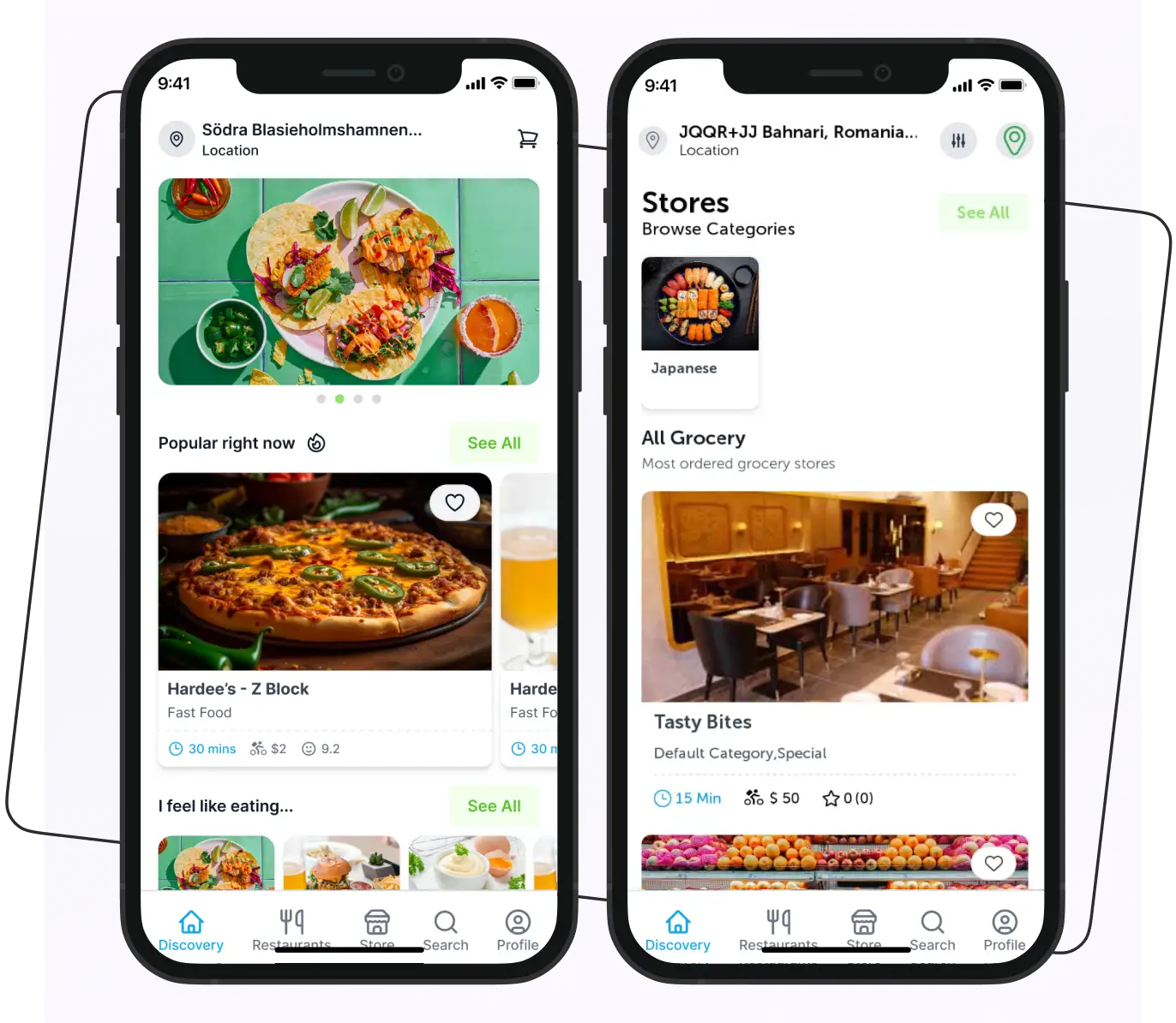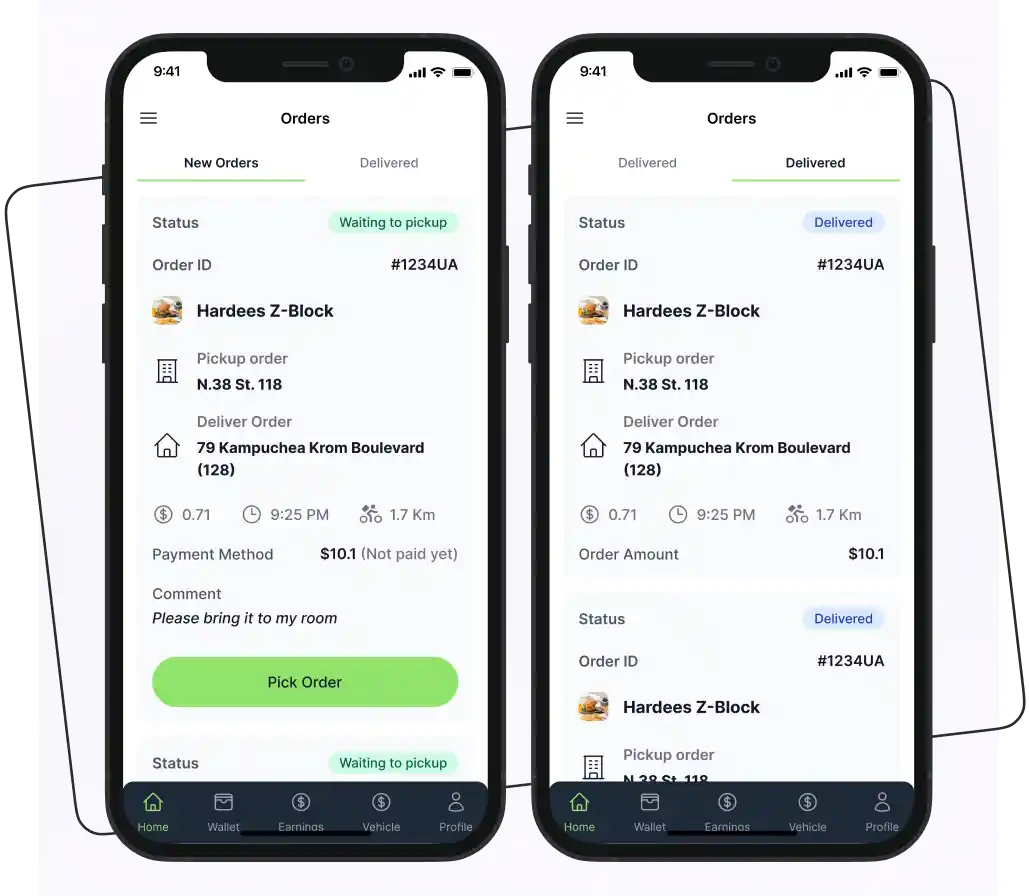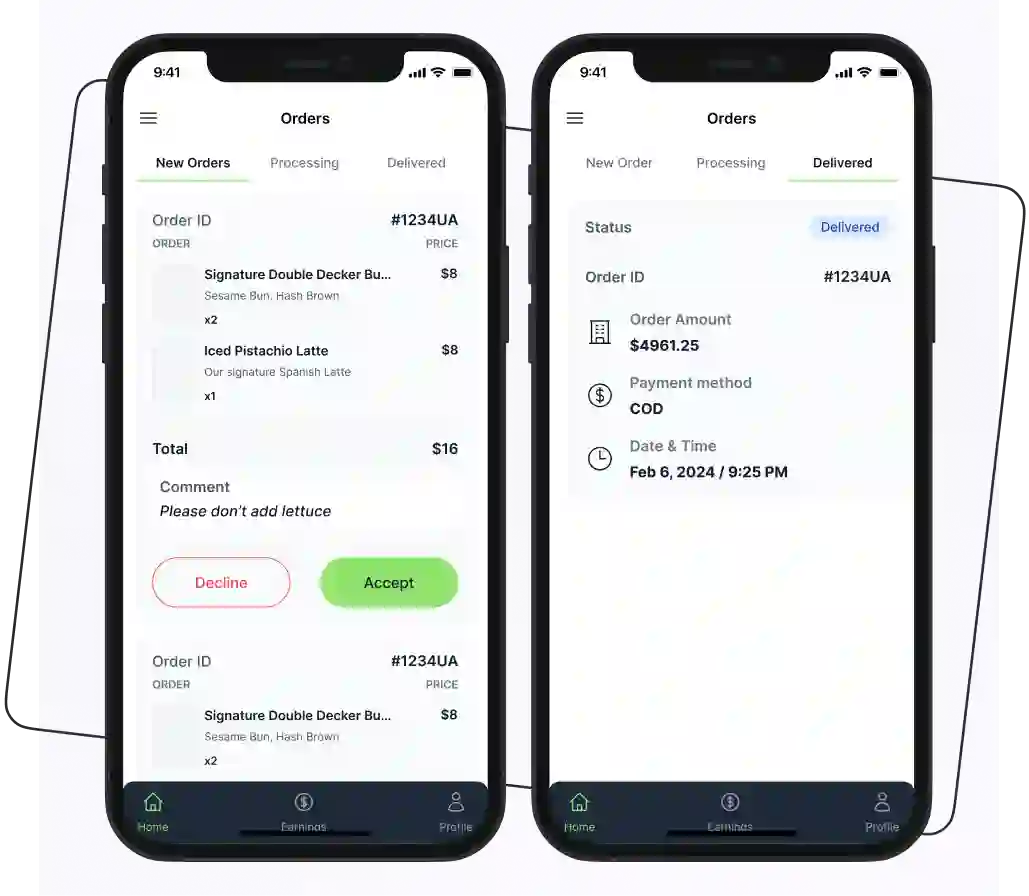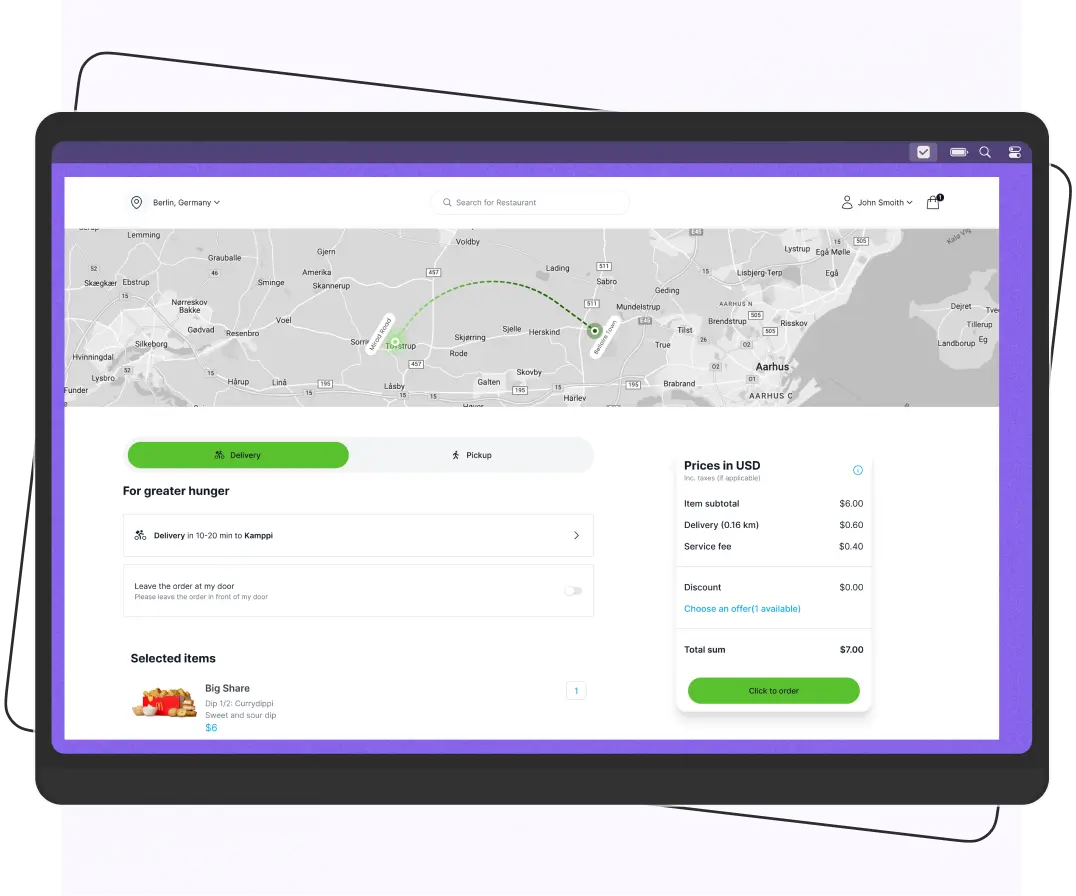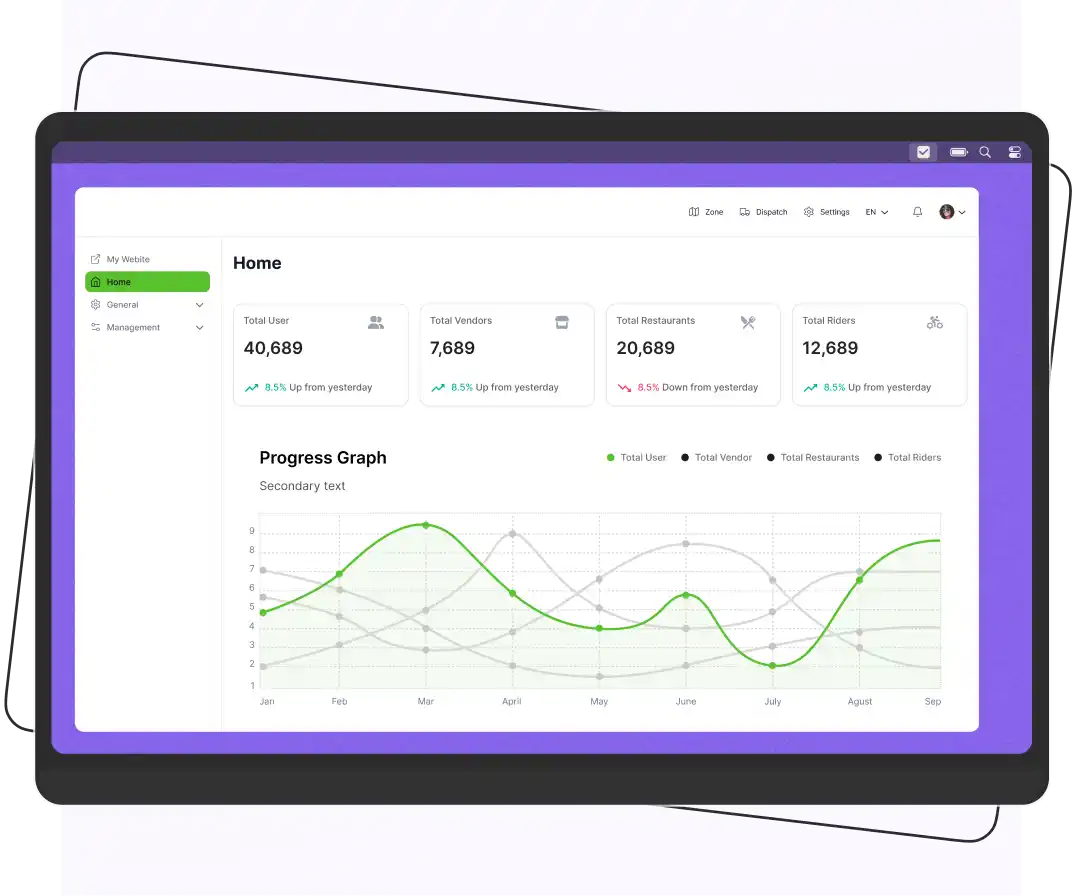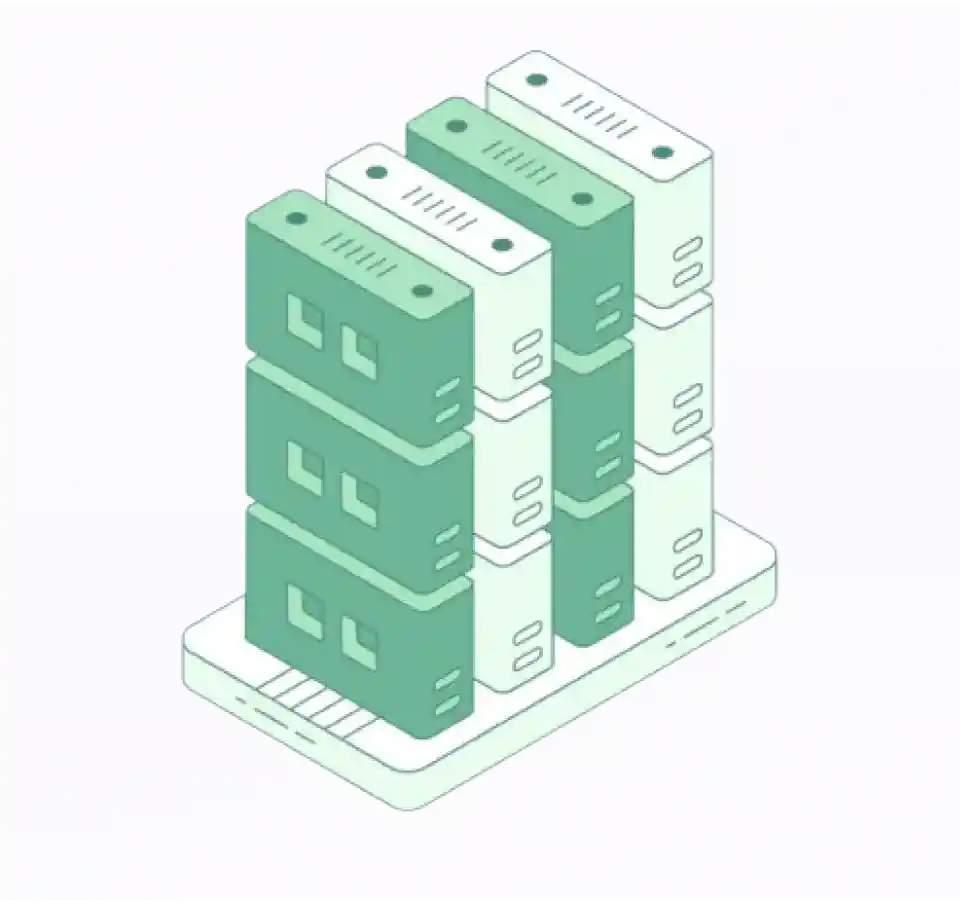
Key Takeaways
- Growing Opportunity: The food delivery market size is projected to hit $1.39 trillion in 2025, making now the perfect time to launch your own food delivery app.
- Types of Business Models: There are 4 main business models. Order-Only, Order and Delivery, Fully Integrated, and Meal Kit Delivery. Each with unique pros, cons, and revenue potential.
- Best For: The Order-Only Model is ideal for startups with low investment, while the Fully Integrated Model suits businesses aiming for full control and brand consistency.
- Tips for Selecting the Right One: Choosing the right model requires considering scalability, cost, customer experience, and market competition.
- Challenges: Logistics costs, customer dissatisfaction, and inventory management can be solved with order tracking, automation, and efficient delivery routing software.
- Business Model Canvas: Use a business model canvas to map out key partners, resources, revenue streams, and costs before launching.
The online food delivery business revenue is projected to reach US$1.39 trillion in 2025. Using food delivery apps to get groceries and other meals has become a daily necessity. Therefore, now is the ideal time for business owners to set foot in this market and start their own food delivery business with a good food delivery app business model.
However, before you jump in, it’s important to get familiar with some key concepts that can make or break your success in this industry. You should know about the top food delivery business model, its pros, cons, and some other things that effectively impact the success of your business.
To help you out, we’ve gathered essential information on various business models of food delivery apps that will help you make an informed decision for your business.
Stats on the Food Delivery Business Model
Below are some vital stats on the food delivery apps business model.
- The number of people ordering meal delivery online is projected to reach 2,691.0 million by 2026.
- 60% of US customers place an order online twice a week.
- According to Statista, 2018-2022, the online food delivery market was 33.2 billion USD.
- In 2020, between February and March, the search for food delivery software increased by 179%.
- By 2022, grocery and restaurant delivery dollar volume will reach $99 billion.
Types of Food Delivery App Business Models
What is the business model of food delivery?
The food delivery business model has different types. We discuss the most popular ones that dominate the online food ordering and delivery market.
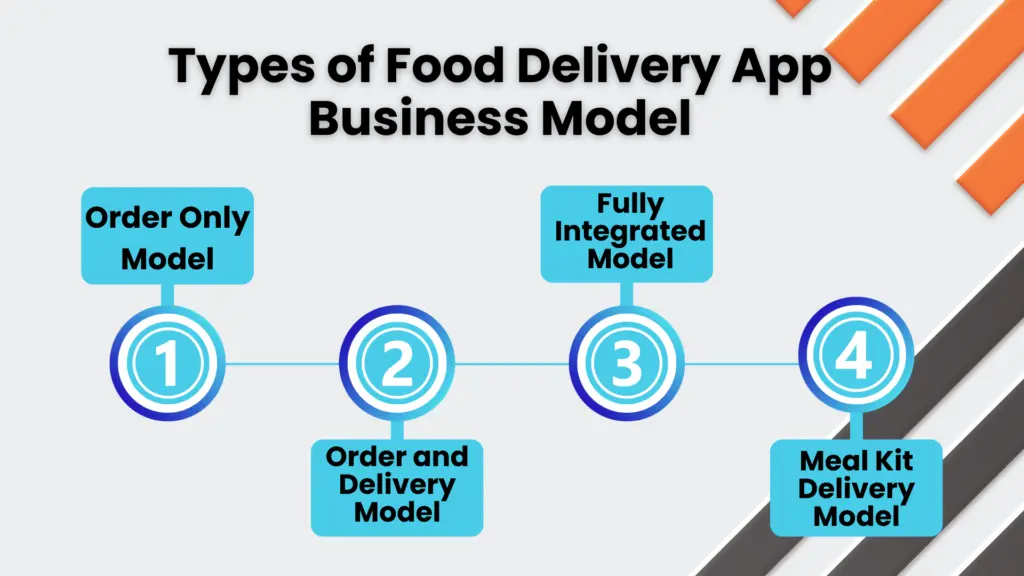
| Feature/Aspect | Order Only Model | Order and Delivery Model | Fully Integrated Model | Meal Kit Delivery Model |
| Ownership of Delivery | Restaurant handles delivery | Third-party/platform handles delivery | Business handles everything (in-house) | Business delivers ingredients only |
| Initial Investment | Low | Medium | High | Medium |
| Scalability | High | Medium to High | Medium | Limited |
| Revenue Sources | Commission fees from restaurants | Commission + Delivery fees | Direct customer payments | Subscriptions or one-time purchases |
| Logistics Responsibility | Restaurants | Platform or delivery partners | Business itself | Business |
| Customer Experience Control | Limited | Moderate | Full | Moderate |
| Example Companies | Just Eat, Grubhub, Delivery Hero | Uber Eats, DoorDash, Zomato | Domino’s (in some markets), Cloud kitchen startups | HelloFresh, Blue Apron |
| Tech Dependence | Moderate | High | Very High | High |
| Profit Margin Potential | Moderate | High (if scaled well) | High (with dense order volume) | Moderate to High |
1. Order Only Model
Best for: Small restaurants, cloud kitchens, and food startups
Customers connect to the local restaurants in this food delivery business model. It performs exceptionally well for the initial generation of on-demand meal delivery services.
With this business model for food delivery, the online ordering platform connects customers to local restaurants. This model also makes it easy for customers to place orders, and the restaurants deliver orders easily.
These platforms typically charge restaurants a commission fee of 7 to 15 percent for each successful order placed through their platform.
Just Eat, UberEats, and Delivery Hero are a few big names that have adopted this model in the food delivery industry.
How Uber Eats Uses the Order-Only Model?
Below is a process that shows how Uber Eats uses an order-only model.
- Platform as a Marketplace
- Uber Eats connects customers with local restaurants through its app or website.
- Restaurants list their menus, set prices, and manage their availability.
- Order Processing
- Customers browse restaurant menus and place orders through Uber Eats.
- The platform forwards the order details to the respective restaurant.
- Restaurant Handles Delivery (Order-Only Aspect)
- In some cases, Uber Eats allows restaurants to use their delivery staff.
- Uber Eats acts as a middleman, ensuring smooth transactions, but does not handle the logistics.
- Revenue Model
- Uber Eats earns money by charging a commission fee (7-30%) on each order.
- Restaurants pay this fee for using Uber Eats’ platform for online orders.
Working of the Order Only Model
The order-only model in a food delivery business focuses primarily on taking customer orders without handling the food preparation or delivery logistics.
Here is the workflow of this model.
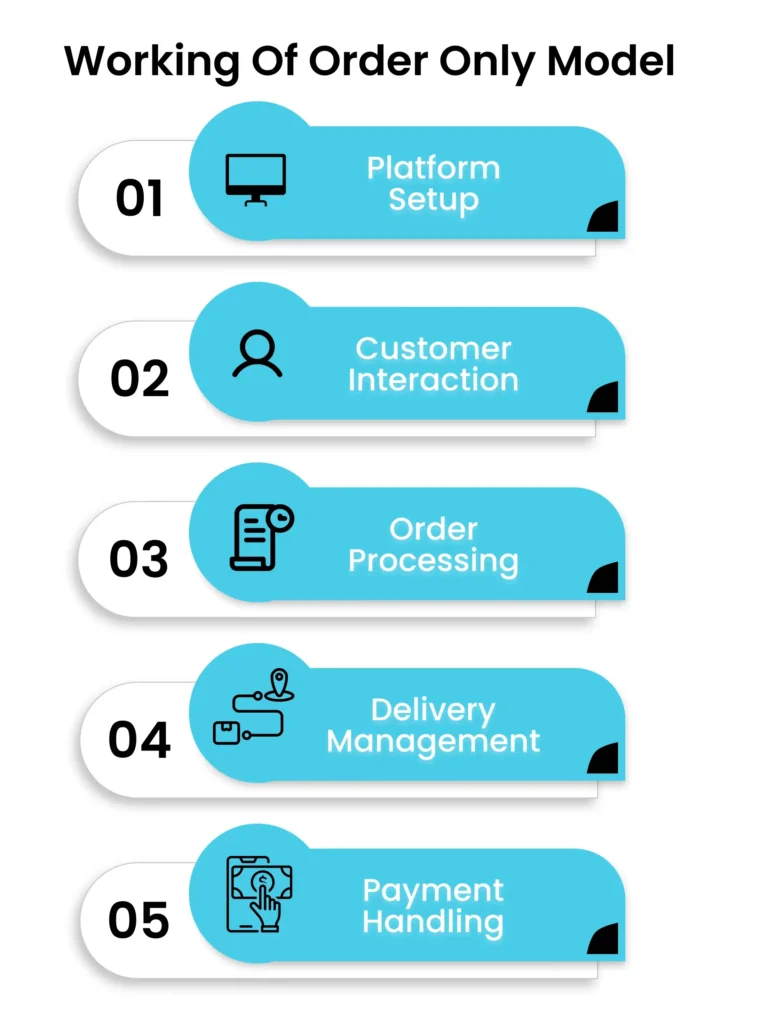
1. Platform Setup
Website/App: A digital platform (website or mobile app) is created for customers to browse menus and place orders.
Partnerships: The service partners with local restaurants or food vendors who prepare the food.
2. Customer Interaction
Menu Display: Customers can view a variety of restaurant menus on the platform.
Order Placement: Customers place orders through the platform, selecting items and providing delivery details.
3. Order Processing
Notification to Restaurant: Once an order is placed, the platform notifies the relevant restaurant to prepare the food.
Order Confirmation: Customers receive confirmation of their order, including estimated preparation and delivery times.
4. Delivery Management
Third-Party Delivery: The model often relies on third-party delivery services (like Uber Eats or DoorDash) to handle the logistics. Alternatively, the platform may employ its delivery staff.
Tracking: Customers can usually track their orders in real time through the app.
5. Payment Handling
Payment Processing: The platform processes payments, typically taking a commission from the restaurant for each order.
Revenue Model: Revenue is generated through delivery fees, service charges, and commissions from partner restaurants.
| Pros | Cons |
| No need to face any issues related to food delivery | Limited menu items |
| Highly scalable | Charge a fixed delivery fee |
| Increased visibility | High commission fees |
| No upfront costs |
Challenges of Order Only Model and How to Overcome Them
Here are some challenges associated with this model and potential ways to overcome them.
Customer Dissatisfaction
Customers expect their orders to be fulfilled promptly and accurately. If the model fails to deliver on these expectations, it can lead to customer dissatisfaction and negative reviews, damaging the reputation of the business.
Solution: To overcome this, it is important to establish efficient processes for order processing, fulfillment, and delivery.
Lack of Visibility
A model may lack transparency and visibility into the order fulfillment process. This can make it difficult to provide accurate order status updates to customers or address their queries effectively.
Solution: By implementing order tracking systems and establishing clear communication channels with customers, businesses can enhance visibility and improve customer satisfaction.
Supercharge your deliveries with Enatega.
Launch Now2. Order and Delivery Model
Best for: Restaurants without their own delivery fleet
The order and delivery model is another type of on-demand delivery business model. In this model, the restaurants are not concerned with the delivery. The logistics company or a third-party courier service handles all the delivery processes.
The delivery service provider works with food delivery platforms to provide food faster. The courier decides on the order delivery costs. Well-known food delivery companies like DoorDash and Zomato use this business model for food delivery.
| Pros | Cons |
| Customization of services | Limited restaurant choices |
| More chances to earn more commission | For setting up your team, invest time and money |
| Control over the entire delivery process | High operational costs |
| There is no need to invest in the delivery fleet | Delivery time constraints |
Challenges of Order and Delivery Model and How to Overcome Them
Below are some common challenges of the order and delivery model, and some best ways to overcome them:
Inventory Management
Efficiently managing inventory is crucial to ensure that products or services are available for timely delivery. Challenges may include inaccurate inventory tracking, stockouts, and overstocking.
Solution: Implementing an automated inventory management system, using real-time data, and establishing strong supplier relationships can help overcome these challenges.
Scalability
As businesses grow, scaling the order and delivery model can be challenging. It involves expanding operations, managing increased order volumes, and maintaining service quality.
Solution: Implementing scalable technologies and investing in additional resources can support the scalability of the order and delivery model.
3. Fully Integrated Model
Best for: Businesses looking to launch a delivery-only restaurant
This best online food delivery model for food delivery service is the most flexible. In this business model, the restaurant owner is responsible for everything from meal preparation to delivering the food to the customers.
This integrated food delivery model serves a specific area, and meal delivery startups frequently work with chefs.
| Pros | Cons |
| Complete control over the process | High initial investment |
| Flexibility in services | Limited restaurant variety |
| Brand consistency | Operational complexity |
| Cost savings | Market entry barriers |
Challenges of a Fully Integrated Model and How to Overcome Them
The main challenge associated with a fully integrated model is high logistics operational costs. One way to overcome this challenge is to increase the density of orders to be able to make multiple deliveries at a time. This way, you can at least lower logistics expenses.
4. Meal Kit Delivery Model
Best for: Casual dining restaurants
This model is also known as the restaurant-to-consumer model. This fast food delivery business model is profitable. In this model, the restaurants deliver premium-quality ingredients to their customers.
This on-demand delivery approach lets customers choose vegetarian and non-vegetarian meals. In this model, multiple restaurants can’t operate. Food businesses usually adopt the meal kit model.
Suppose the businesses want to opt for the meal kit delivery model. In that case, they will hire a team of chefs to create innovative recipes, a staff to distribute the meal kits, and suppliers to provide quality ingredients.
| Pros | Cons |
| Time-saving | More expensive |
| Convenience | Cooking skills required |
| Reduced food waste | Market competition |
| Don’t rely on third-party delivery platforms |
Challenges of the Meal Kit Delivery Model and How to Overcome Them
The quality standard is the main challenge of the meal kit delivery model. To resolve this problem, you should partner with established businesses that deliver fresh, high-quality ingredients in the right quantity, at the right time.
Food Delivery Business Model Canvas
Here is a business model canvas for a food delivery service:
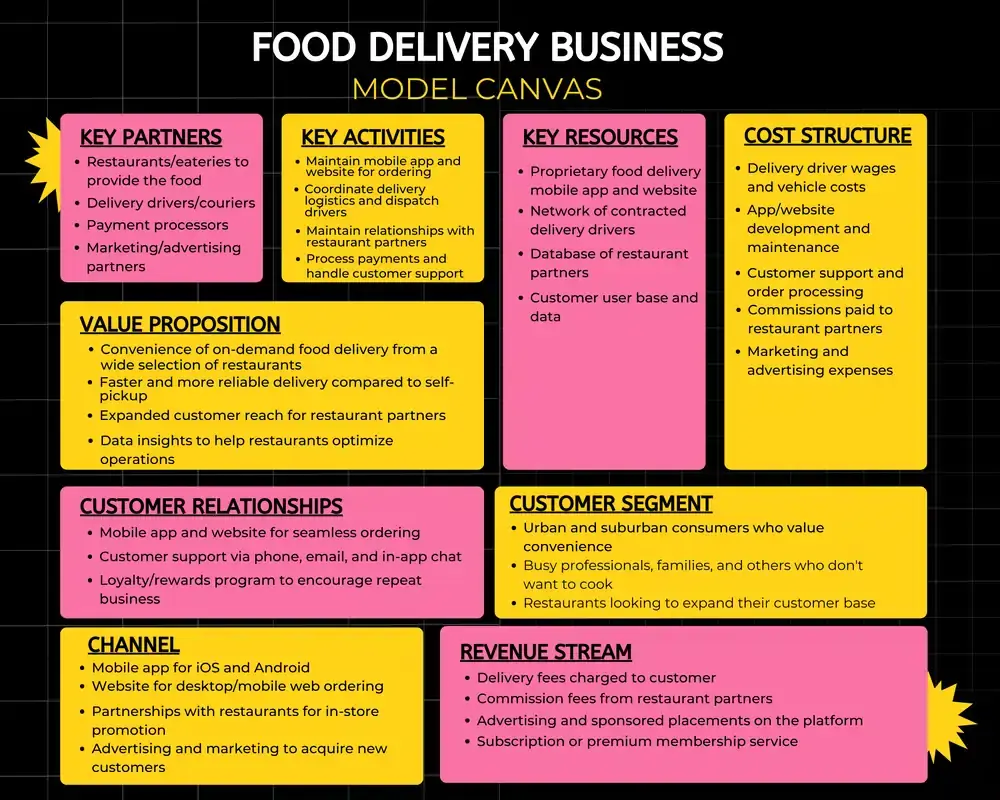
Factors to Consider for Choosing the Best Food Delivery App Business Model
A successful food ordering and delivery business follows a specific food delivery revenue model and business model.
However, when several business models of food delivery apps are available, it is challenging to choose the right one. Therefore, we have compiled some tips to help you make the right decision.

Understand Your Needs
You have to identify your business needs and goals and then choose the delivery service business model according to them. You must also evaluate your financial capacity. Otherwise, it becomes a huge problem.
Do Research
Before starting an online food delivery business, invest some time in a market analysis. Conduct thorough market research and understand the latest food delivery trends and your target audience.
Competitor Analysis
Study existing food delivery apps in your target market. Analyze their business models, strengths, weaknesses, and customer feedback to identify opportunities for differentiation.
Scalability
Choose a model that allows for scalability. Your business should be able to grow and adapt to increased demand, expanding to new locations or offering additional services.
Differentiation
Identify a unique value proposition differentiating your food delivery app from competitors. It could be special features, exclusive partnerships, or a focus on sustainability.
Cost
Evaluate the expenses associated with selecting the business model. Consider factors such as app development, server costs, software updates, and ongoing technical support. Also, determine the commission or fee structure charged to restaurants or customers.
Customer Experience
Providing a seamless and enjoyable experience for customers is crucial for the success of a food delivery app. Make sure that the business model you select can help you provide the best experience to your customers.
Steps to Create the Food Delivery App Business Plan
How to start a food delivery app business?
A well-crafted business plan is a roadmap for your business. It acts as a guide that outlines the main steps needed to ensure the success of your business.
Below are some steps to help you create a food delivery business plan.
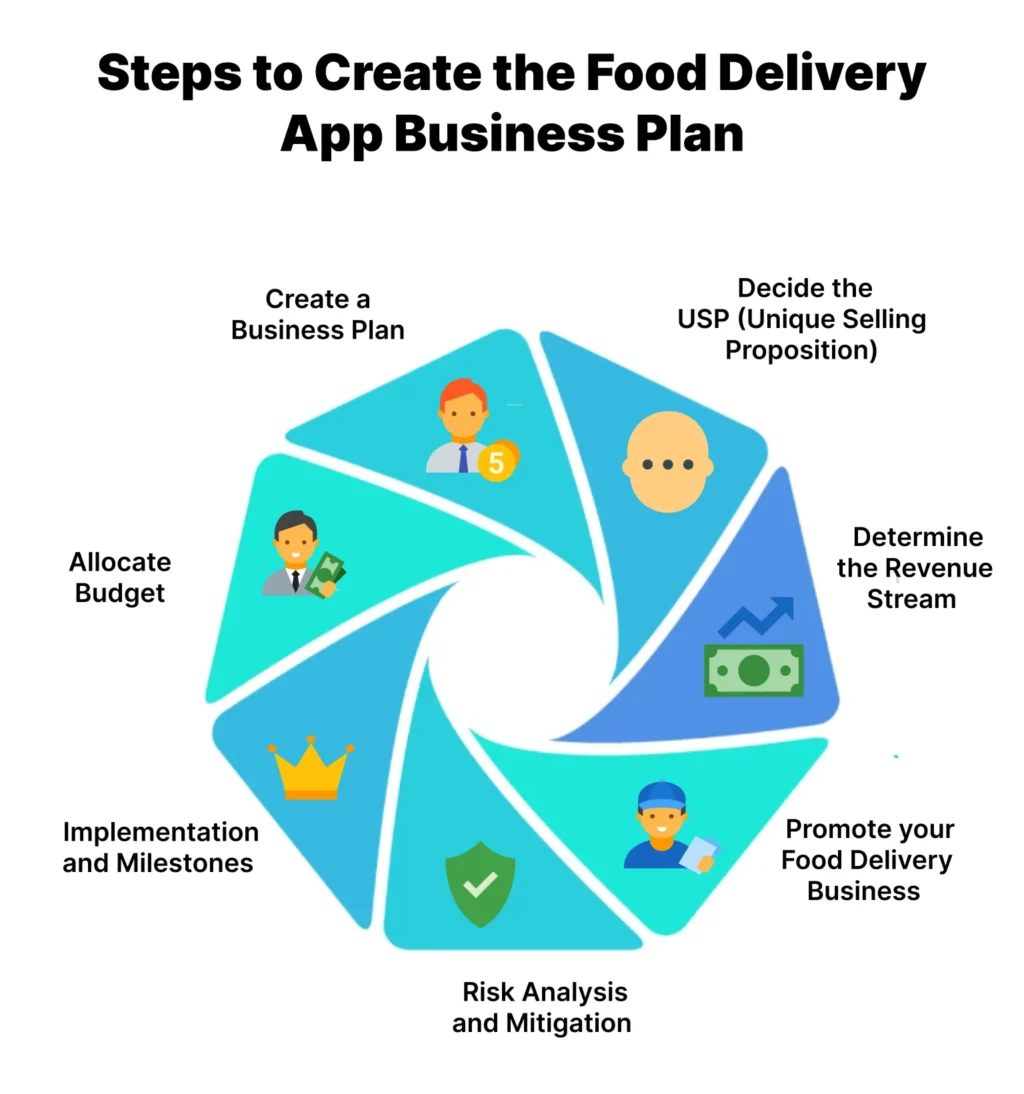
1. Create a Business Plan
Before creating the menu, you must create a food delivery business plan. For effective planning, a daily planner template can assist you in structuring your business plan and staying on track with both short-term and long-term goals that align with your business objectives.
Make sure that you have a clear understanding of the mission and vision that you want to achieve.
2. Decide the USP (Unique Selling Proposition)
Select the unique approach that helps you stand out in the competitive food delivery market. You must identify your USP that makes you different from or better than your competition.
Moreover, it is the distinguishing factor that makes your customers return for your services and products.
Here are some ways that help you identify the USP for your business.
- Brainstorm ideas
- Identify your customer
- Analyze your competitors
- Identify your strengths and weaknesses
- Make your USP clear and concise
3. Determine the Revenue Stream
Identify the revenue stream you can use to generate revenue for your business. Several revenue stream methods are available, so choose the one that aligns with your business objectives.
4. Allocate Budget
In this phase, you have to follow these strategies:
- Prepare detailed financial projections, including revenue, expenses, cash flow, and profitability.
- Identify the funding requirements and potential sources of capital, such as investors or loans.
- Outline your pricing strategy and revenue model (e.g., commission-based, subscription, or a combination).
5. Promote your Food Delivery Business
It is the main step that you should add to your business plan. It shows you how to promote your successful food delivery business from scratch.
- Describe your marketing channels and campaigns to attract and retain customers.
- Explain your sales strategy, including any partnerships or distribution channels.
- Discuss your branding and positioning within the food delivery market.
6. Risk Analysis and Mitigation
Identify the potential risks and challenges your food delivery app may face, such as regulatory changes, competition, or technological disruptions. Outline your strategies to mitigate these risks and address any contingencies.
7. Implementation and Milestones
Provide a detailed implementation plan, including the development timeline, launch strategy, and key milestones. Discuss any legal or regulatory considerations that may impact your business operations.
FAQs
1. Who uses food delivery apps the most?
Adults mostly use the food delivery apps with lower incomes ($0-$9k). While just the third-highest income ($150–175,000) also uses food apps.
2. What food delivery app costs the most?
UberEats is the most expensive food delivery app, costing 104.2% more than buying directly.
3. What is the concept of online food delivery?
Online food delivery is buying food online from different restaurants and delivering the food to the doorstep. The process of online food delivery is simple and consists of some steps, such as:
- Customers browse the restaurant
- Check the menu items
- Choosing an item
- Choose the delivery option
- Make a payment
- Order confirmed
- The restaurant prepares the order
- The rider delivers the order
4. What is the aim of an online food ordering system?
The main aim of an online food ordering system is to provide a platform that simplifies the ordering process for customers and restaurants. With an online food ordering system, restaurants can manage their operations seamlessly, and customers can order food online without hassle.
5. How much does it cost to develop a food delivery app?
The development cost of the food delivery app depends on various factors, such as:
- Complexity
- Features
- Platform
- Development method and more
6. Are food delivery apps profitable?
Yes, creating food delivery apps for your business is profitable and helps you generate revenue.
7. How much does it cost to develop a meal kit delivery app?
For meal kit delivery app development, the average cost ranges between $15,000 – $60,000. Design, platform, tech stack, features, time required, and development team are the factors that influence the cost.
8. How much money can you make with food delivery apps?
Earnings from food delivery apps can vary widely, ranging from $10 to $25 per hour, depending on factors like location, demand, and tips. Some riders report making up to $1,000 or more weekly during busy periods.
9. What business model does DoorDash use?
DoorDash operates on a marketplace model, connecting customers with local restaurants and delivery drivers. It generates revenue through delivery fees, service fees, and subscription services like DashPass.
10. What is the business model of Uber Eats?
Uber Eats uses a marketplace model to connect customers, restaurants, and delivery drivers. It earns revenue through delivery fees, service charges, and partnerships with restaurants, along with subscription services like Eats Pass.
11. What is the DoorDash 3-sided business model?
DoorDash’s three-sided business model involves:
- Consumers: Customers order food through the app.
- Merchants: Restaurants partner with DoorDash to increase sales and reach a broader audience without needing their delivery infrastructure.
- Dashers: Independent delivery drivers (Dashers) are contracted to fulfill orders, providing flexible work opportunities.
12. What is the business model of meal kit delivery?
Meal kit delivery services operate on a subscription model, providing customers with pre-portioned ingredients and recipes to cook meals at home. Revenue is generated through subscription fees, offering flexible plans, and sometimes selling additional products like kitchen tools or snacks.
13. What is the business model of Grubhub?
Grubhub operates on a commission-based business model, earning revenue by charging restaurants a percentage of each order and delivery fees from customers. Additionally, it offers subscription services like Grubhub+, which provides benefits like free delivery for a monthly fee.
14. What is the business model of Instacart?
Instacart’s business model is based on charging grocery retailers a commission on sales generated through its platform, along with delivery fees from customers. It also offers a subscription service, Instacart+, which provides benefits like reduced delivery fees for a monthly or annual fee.
Supercharge your deliveries with Enatega.
Launch NowConclusion
The food delivery app business model has proven to be a recipe for success. It creates a win-win situation for restaurants, customers, and the platforms. The on-demand online food delivery business model will be essential for food delivery apps to stay ahead of the curve and satisfy the ever-changing tastes of consumers.
You need to select a model that allows you to cover your expenses and generate profits. If you're new to meal delivery, start with an order-only model, then add another model when you get ready to handle more restaurants. Every business model we've discussed needs route planning and optimization software to help delivery partners locate the shortest route.
You can also use the online food delivery business model canvas tool to analyze and plan the various components of a business model. Choose the right business model and make the customers engage to reach success.
Now you have all the information, but you still need help. Get a free tailored analysis of your food delivery business idea with Enatega. Discuss your requirements, and we will help you select a suitable online food ordering business model.












 IOS
IOS Android
Android Web
Web